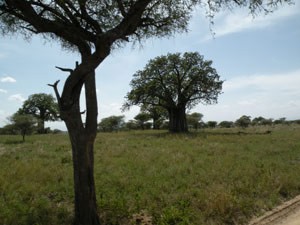On a recent trip to East Africa I was swept off my feet by the baobob tree, as has happened to many other travelers. How can a long-lived, successful tree be so entirely unlike all the other trees, including other tropical trees? It gives a new perspective to the world of trees.
In the dry season, when baobobs are leafless, you can see that the fat trunks sprout a mop of disproportionately wimpy branches. It looks just like a root system in the air. This observation is supported by one explanation of the baobob’s form: A long time ago, every creature was given its own tree and the hyena received the baobob. The hyena was so disgusted with its assigned tree that it shoved it into the ground upside down.
Baobobs are reasonably large, growing to a height of 60 feet or so, but their trunks are enormous, sometimes 30 feet in diameter. It was during the wet season when I visited, and the baobobs I saw were all leafed out. Their palmate leaves cast a dense shade. More animals were to be found sheltering from the sun below baobobs, and it was in their branches that we looked for leopards. Baobobs store vast quantities of water in their abundant soft wood and in their hollow trunks, allowing them to maintain a dense canopy in an otherwise parched landscape.
Acacia trees are far more common in the savannahs and far more restrained in their use of leaves, keeping only a thin layer at the best of times, as though to maximize each leaf’s efficiency and minimize the tree’s use of water on the droughty African savannah. It’s easy to get sunburned in the shade of an acacia.
We are used to trees that fine tune their strategies in order to keep up with many other species doing that very same thing. The upside-down tree seems to turn these notions on their heads.
Evolution, as we know, takes place by way of incremental small changes: over a very long haul the oak slowly differs from the beech. Baobobs on the other hand, seem to have been plunked down as extreme outliers. There probably is another version of the story of their development, but for the moment, taking an everyday tree and heaving it into the ground upside down provides an adequate explanation of the baobob.


